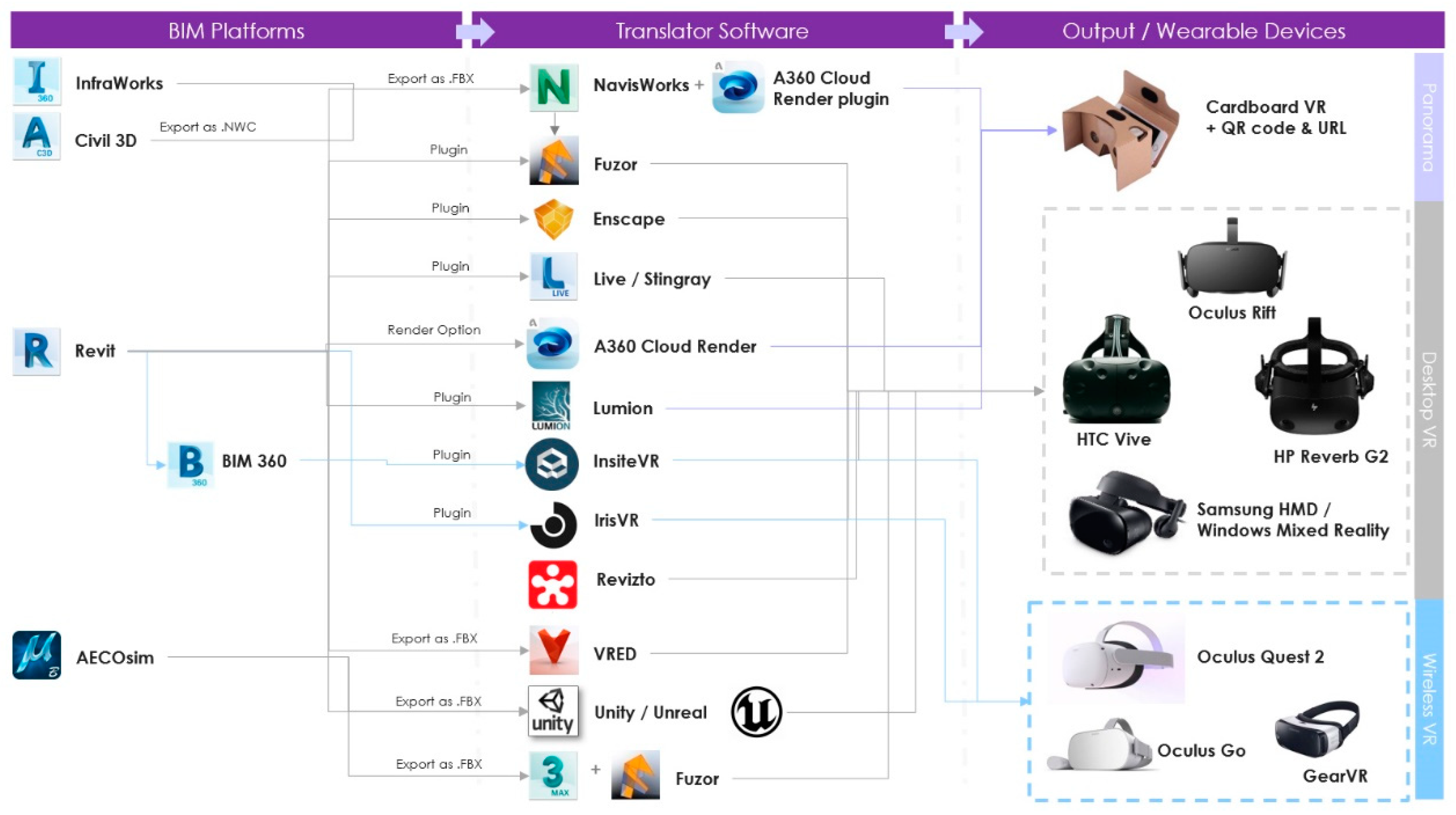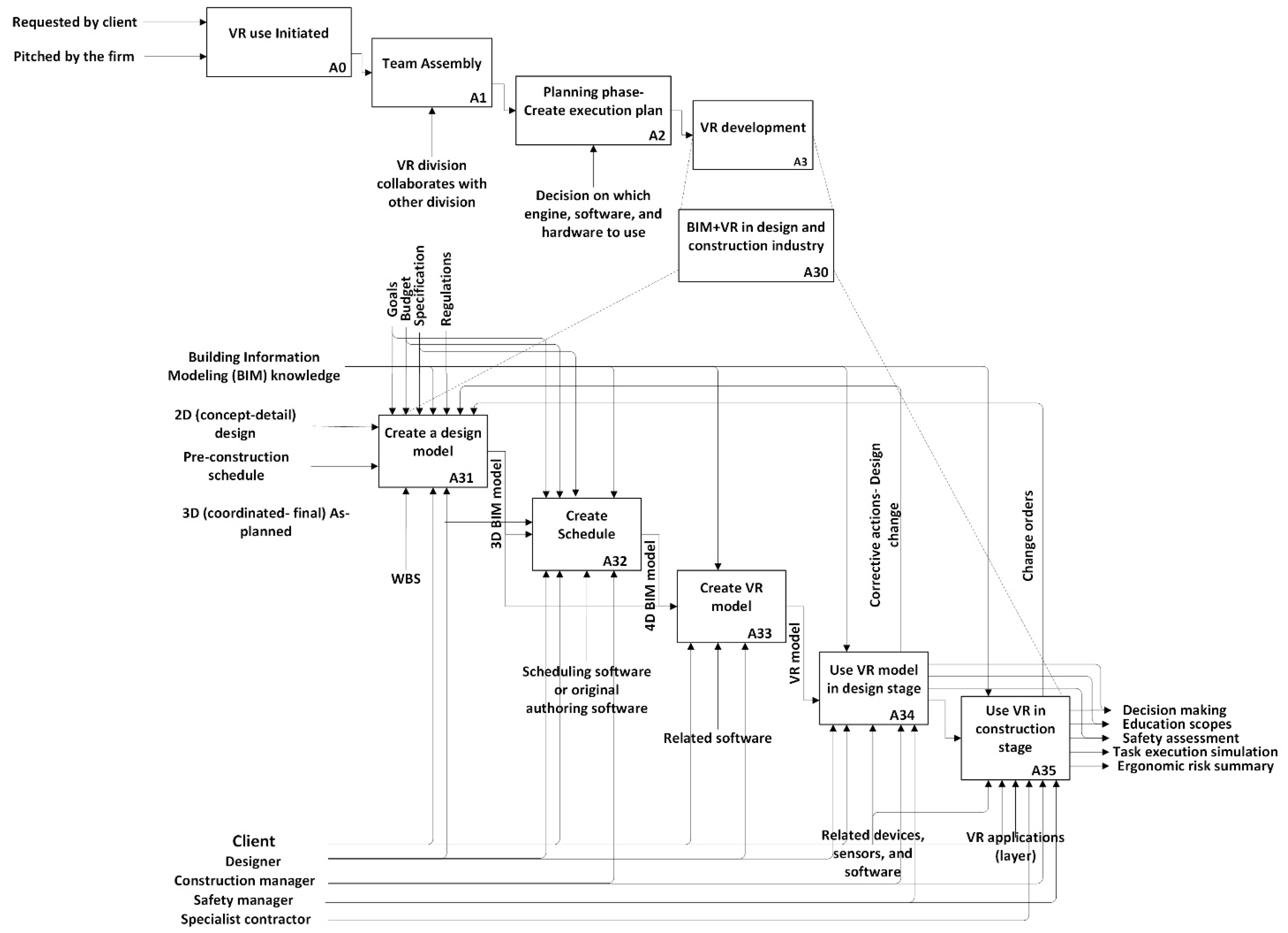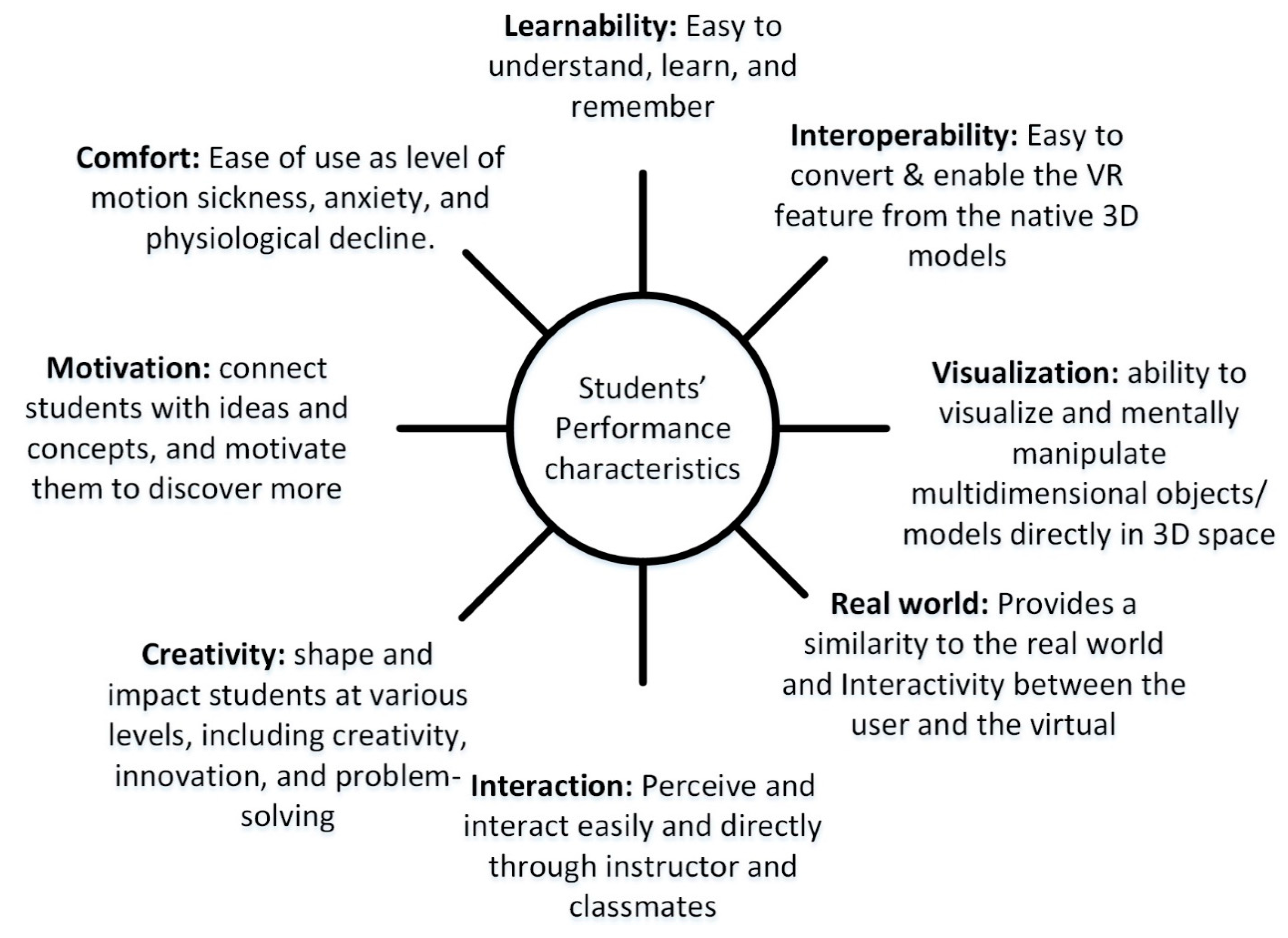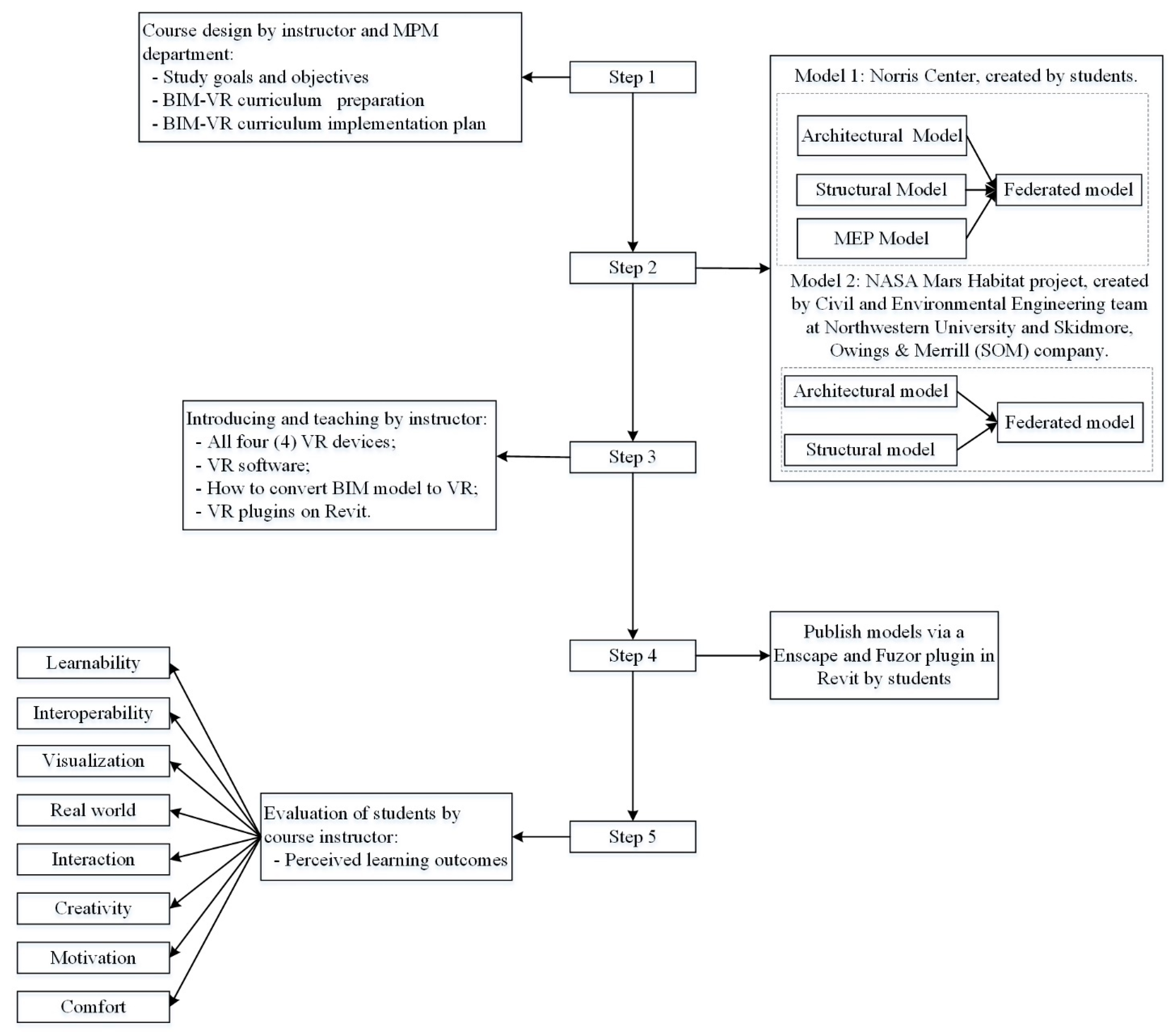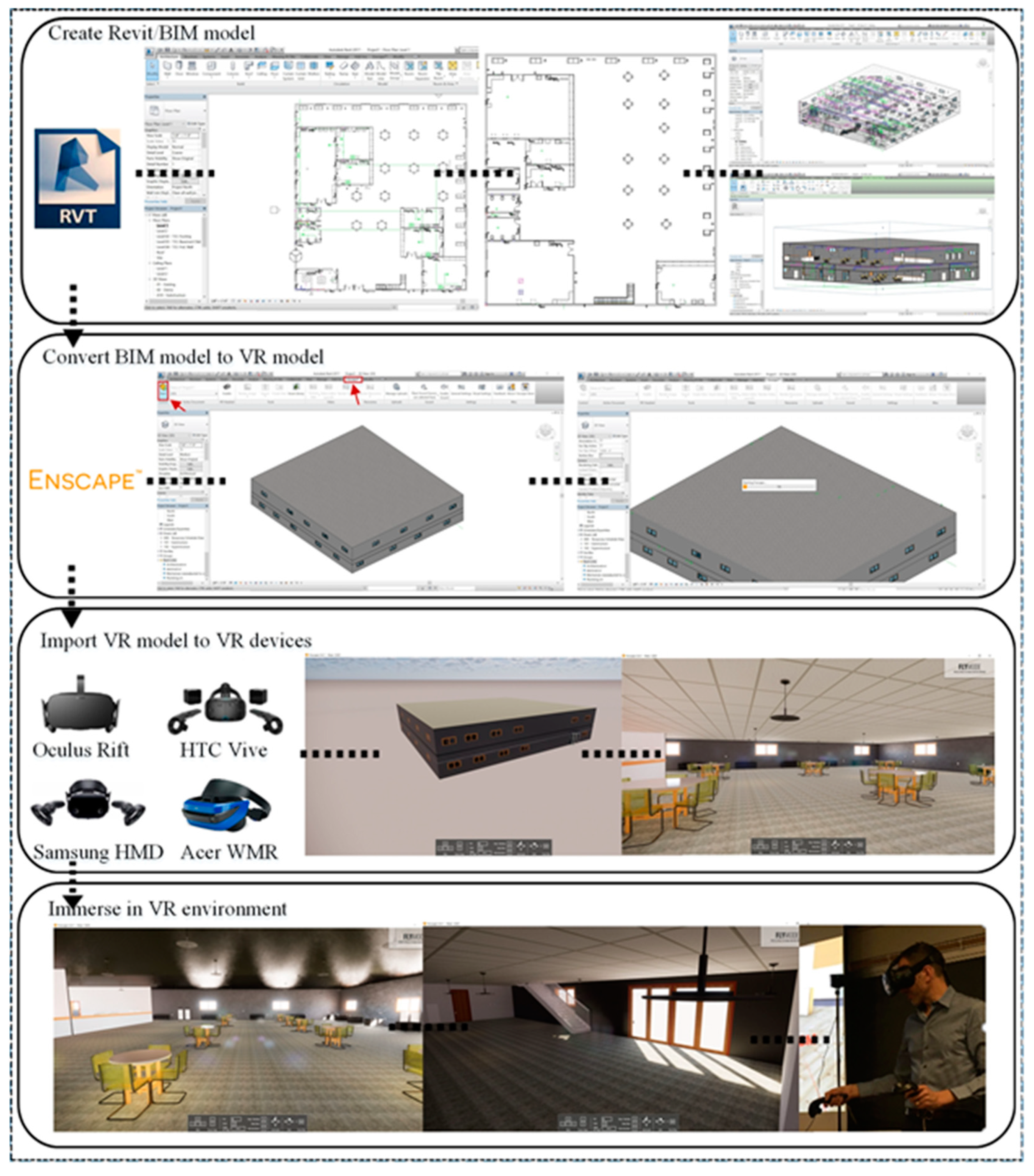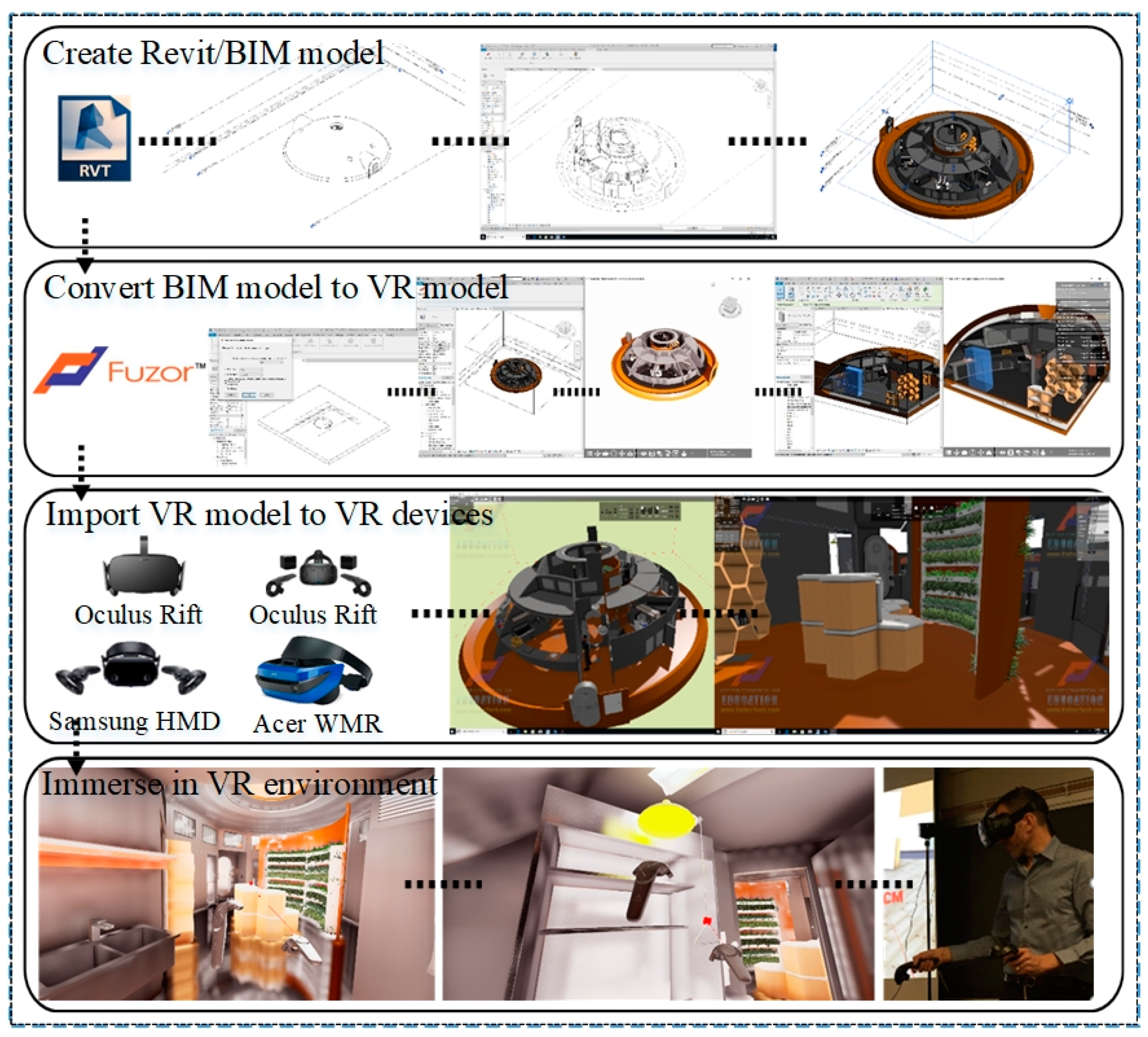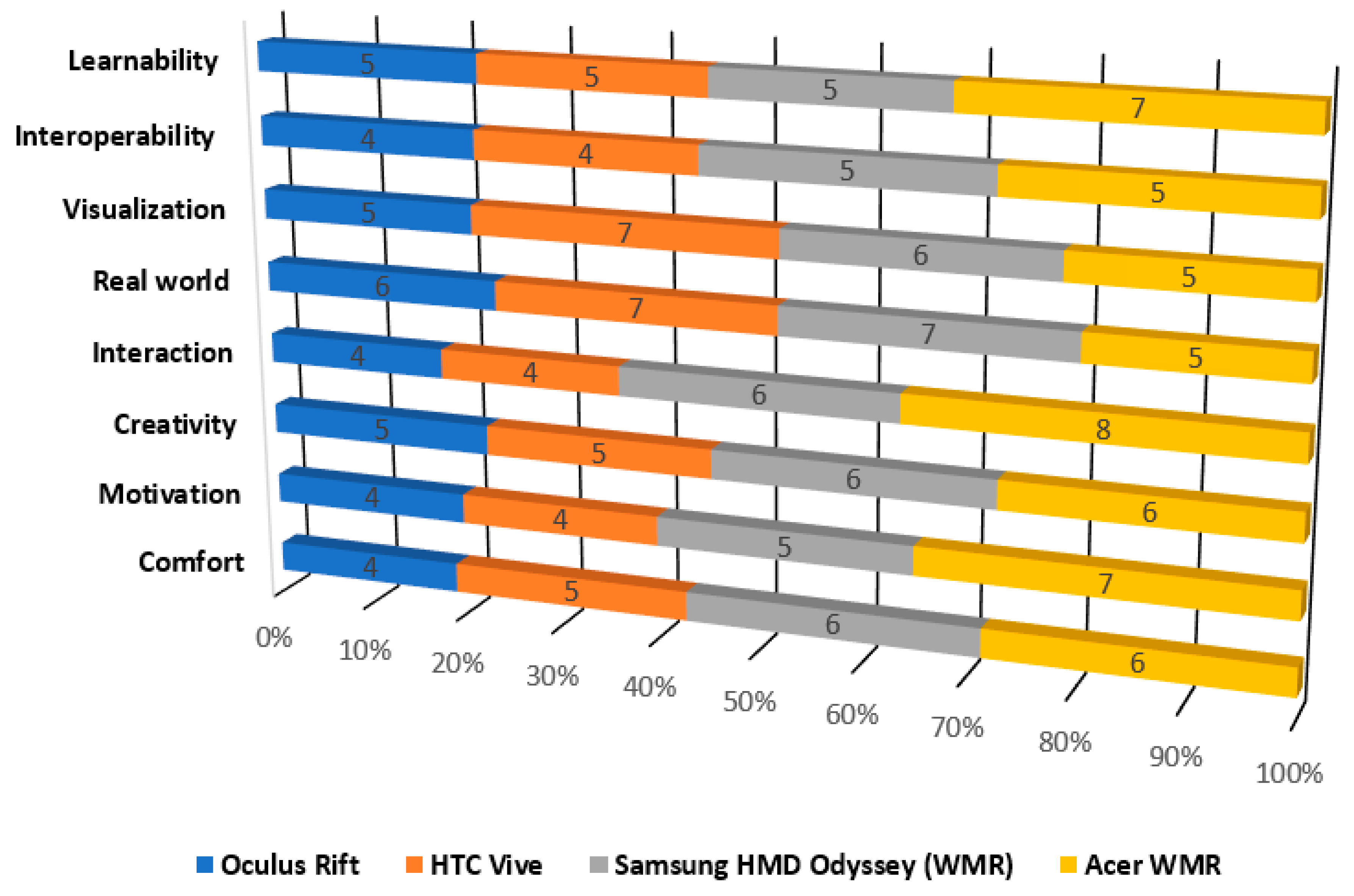This segment summaries significant research projects in the four main areas related to topic of this research: (1) the evolution of BIM in AEC; (2) visualization of BIM model over VR (BIM-into-VR); (3) Development of an IDEF0 model for BIM-into-VR workflow; and (4) application of BIM and VR in AEC education/training.
2.1. The Evolution of BIM in AEC Industry
Saieg, et al. (2018) defines BIM as: “BIM is a set of interacting processes, roles, policies, and technologies creating virtual information-based models to manage data in the digital format used within the AEC industry to design, construct, and maintain a project throughout its life-cycle” [
16]. BIM has been accepted as a valued tool for improvement in the design and construction stages of projects due to its rapid growth, adoption, and implementation. BIM has become the standard process for communicating design and construction details in AEC projects. Different vendors have produced many applications with powerful BIM functionalities to create, implement, and manage nD BIM models, which can be used in the project’s lifecycle [
17].
Domain professionals must iteratively update BIM data during a project due to the growing set of requirements and complex systems of a construction project [
18]. This information needs to define and explain by a significant level of trust, precision, and transparency in BIM models. Different disciplines utilizing BIM in the construction environment have various nomenclatures, varied vocabularies, different data formats and geometries, diverse computing paradigms, and distinct essential world views [
3]. These disciplines and construction companies have different standards and processes for their communication and delivery procedures. One way to solve these issues is the standardization of implementing BIM and utilization of a detailed BIM Execution Plan (BEP) [
19]. The application of BIM in AEC projects for design, construction, and maintenance would generate, manage, and support critical data, information, and reports. The BIM application will lead to realizing a cost-effective design and better communication among AEC professionals.
Table 1 shows some of the different applications for BIM, which have been defined from the literature.
BIM is an essential piece of the solution, helping to deliver more efficient design, build, and operations, but its value grows exponentially when shown in a more realistic way than a 3D model. To understand the VR concept, it needs to be broken into two characterizations of psychological and technical. Perception and simulation are the two main keys to VR. Humans’ perception of reality is a blend of sensory information and how humans manage this information to shape their awareness of what is going on, how it is going on, where it is going on, when it is, and why it is going on. VR shows these schemes and processes with information that is not really there but is captivating enough for us to feel it as reality. VR is an emulation of a situation that humans see or feel as real. VR defines a digital setting that can be experienced and explored by a person from a technical perspective. Four significant conditions must be achieved in order for a VR experience to be considered a success. It must be believable, interactive, explorable, and immersive. VR is a simulation and immersive environment projected through a wearable headset that places the curated world in the user’s sight. The main incentive for using a VR application is that it provides the possibility to test with those circumstances that “cannot be accessed physically,” “expensive be accessed physically,” or “dangerous be accessed physically” [
61]. With the continuous development of technology, VR technologies have attracted the increasing attention of a broad area of applications [
62], such as architecture, cinema and entertainment, risks identification, medical science, video games, engineering, urban design, education and training, and so on.
Research on VR technology applications in various stages of AEC projects has shown the benefits these applications can bring to all projects [
63]. VR technology has been effective in project schedule control [
64] and construction safety training [
65]. It can also identify design issues [
61] to help users comprehend a project complexity, make better design decisions, and improve collaborative decision-making [
3]. VR technology provides environments for greater collaboration among project participants [
66] and enables a better understanding of complex designs [
67]. There are some VR software applications developed by gaming engine (e.g., Unity, and Unreal) which allow the users to have the interactive simulated feelings. In addition, the applications like IrisVR and Resolve provide the multiusers meetings built for instant collaboration in the VR environment. All stakeholders can benefit from VR at various project design phases—namely, schematic design, detailed design, construction detailing, and maintenance [
68]. Architects and designers can use VR technology from beginning design mock-ups to project collaboration to the end of the project. VR has the potential to sell an idea stronger and better than other applications. Jumping into VR during the concept and layout process allows the designer to justify a proof of concept. VR enables users to see and interact with the actual design. A virtual walkthrough experience is superior to the already-great experience of seeing the project in 3D or 4D on a large screen or a projector [
69]. This enhanced experience enables all stakeholders to get a feeling for space and design that they are not able to get through other ways, not even with a BIM model. Architects can work through design errors in a virtual space, improving the chances of spotting problems before starting the project.
VR can provide an entirely new understanding and appreciation of design. This is because VR offers the ability to test in context [
70]. Contractors can now bring the job site to the office and even walk a fully constructed rendering of their project before breaking ground. VR can be a highly efficient communication platform for stakeholders who are not from the AEC industry and have no cognizance of regular construction contracts. Further, VR reduces the understanding gap among project owners and designers and visual and non-visual thinkers. The ability of VR to grab the attention of people in a project presentation session that might otherwise be boring can be considered another benefit of using VR during project design development and construction. VR provides the ability for CAD data to be viewed from every direction and helps accelerate the design workflow. When it comes to clients, immersing them in the model enhances understanding the concept while validating the overall design. Clients can also experience a more natural interaction with designs, allowing for walk-throughs that feel more realistic, especially for non-CAD experts. VR also assists in resolving logistical concerns faster by employing in a shared, immersive environment. Safety issues, transportation routes, and site staging can be addressed earlier. During the design process, VR allows problems to be identified by viewing real scales’ issues. Finally, architectural engineering construction projects can utilize VR to view remote locations, reduce travel time, and optimize the overall expense. For the AEC and manufacturing industries, VR provides a new age of efficiency, connectivity, and mobility that offers new opportunities to advance their competitive advantages while becoming more productive and safe in their practices.
Table 2 shows some of the different VR applications in the AEC industry, which have been defined from literature.
2.2. Visualization of BIM Model over VR (BIM-into-VR)
The process of BIM usage signifies an advancement compared to customary procedures of developing and managing construction projects. Even though BIM adaptation has grown in recent years, there are still obstacles and restrictions in its comprehensive implementation [
81]. Using VR to visualize the rich, accurate, and smart data included in a BIM model can support and produce interactive real-time project visualization for a consistently shared perception with main participants [
3,
82]. This arrangement has also shown a prospect of allowing the project leadership to envision and identify a project’s intricacy for successful communication in all stages.
Table 3 summarizes the published study works which employed VR with or without BIM for AEC projects.
Nowadays, in most design and construction firms, BIM is somewhat a standard for AEC projects, but most of these firms do not use VR systems. Like BIM, which works with BEP, the VR needs to work based on a comprehensive workflow. A common VR development workflow is prepared after a project owner is requested to use VR technology and approves it. Then, the VR group will be brought to the project. The VR conversion would be performed by using a commercial software product or in-house. VR requires headsets and sensors to track location and movement and stereo headphones to produce surround sound.
Figure 2 summarizes all the available processes and steps for converting a BIM to a VR model.
IDEF0 is an acronym for ICAM definition for function modeling, where ICAM stands for integrated computer aided manufacturing. IDEF0 is a methodology that can describe complex functions such as technological practices and that allows for the development, analysis, and integration of systems such as BIM and VR. The proposed model represents a safety management model for construction sites. The model is described schematically as an IDEF0 diagram. The authors describe the BIM-into-VR workflow in this model to help everyone understand the processes. The boxes in
Figure 3. describe key processes. The model designed by the authors of this manuscript is based on their knowledge from previous publications, industry case studies, and their experiences as a best practice process.
Figure 3, illustrates all stages of creating a 3D or 4D (3D + time) model (optional) up until the time that model is used in VR for different purposes in the AEC industry. All steps of generating models in the design phase until it is converted to use in VR in a construction project are presented in
Figure 3. Step 1 is collecting data that comprises structural, architectural, and MEP designs in 2-D and 3-D models and essential data regarding schedule and cost (if 4D BIM is required). Incorporating this information generates a federated 4D-BIM/as-planned model (A31) and (A32). A VR model is created based on specifications, BIM knowledge, and designers’ and stakeholders’ ideas (A33). The generated VR model can be utilized to analyze the design and evaluate different design choices to perform remedial actions on design and make better design choices (A34). When the problems are fixed and stakeholders have accepted the design, it is then transferred to the construction site managers to evaluate and understand the design and implement, analyze, and control the project (A35).
2.3. BIM and VR in AEC Education/Training
Institutional education has a vital role in BIM transition. Future AEC community leaders who can transform the industry paradigm throughout their careers are universities’ products. Numerous researchers have stated the significance of BIM-based education in AEC-related programs. Sacks and Barak [
91] replaced traditional civil engineering graphics courses with BIM for first-year students. Azhar et al. [
92] examined the effectiveness of BIM instruction by surveying students’ perceptions. They demonstrated how BIM improved students’ understanding of construction project management. Research by Clevenger et al. [
93] identified several methods in that BIM can be incorporated into the curriculum. These include providing standalone courses and/or updating existing courses to embed material on BIM. In another study, Wong et al. [
94] studied the status, weaknesses, strengths, and professional possibilities of BIM-based education. Peterson et al. [
95] added BIM to their construction project management courses and showed how BIM could support and increase student understanding. Khosrowshahi and Arayici [
96] found teaching BIM is vital in the AEC industry roadmap for BIM execution. Abdirad and Dossick [
97] propose that BIM is an essential subject to be taught in college because of industry demands and because the development of strategies for delivering BIM is complex. Shelbourn et al. [
98] studied very similar research about integrating BIM into the USA and UK undergraduate curriculum. The investigation highlighted a discussion regarding whether BIM should be a standalone unit or integrated into courses. The study recommended that BIM present students with an opportunity to understand the building’s construction methodology further. For instance, Zou et al. [
99] observed the necessity to optimize BIM-based education resources to bridge the gap between academia and industry practice. Jin et al. [
100] researched on students’ understanding of and individual views of BIM that were intuitive to both BIM instructors and companies.
On the other side, the number of VR scenarios can be broadly applicable to many education and training areas. Many researchers have remarked on the significance of VR-based education in programs related to AEC. VR can generate different virtual learning environments, tough to touch, dangerous to manage, or even things that do not exist in reality [
101]. Pedro et al. [
102] results indicated that their BIM-based VR system could experientially improve hazard identification ability, transfer safety knowledge, and engage students. VR allows learners to investigate virtual environments from different viewpoints, empowering them to freely examine creative impulses and provide them with a more comprehensive understanding of learning targets [
103]. Therefore, VR technology is less risky and more cost-effective than conducting scenarios in reality. Bhagwat and et al. [
104] believed that the advent of new visualization platforms such as building information modeling (BIM), virtual reality (VR), and gaming technologies provides a unique opportunity for the AEC students to see and experience the new ways of design, implement, and manage safety. In summary, VR technologies have the potential of:
Providing outstanding visualizations that were not imaginable in a traditional system;
Creating curiosity by helping students become more dedicated and inspired;
Increasing student commitment by grabbing and holding their attention (because VR makes it challenging and thrilling to interact, create, and manipulate objects in a virtual setting);
Helping students realize intricate topics, concepts, and theories;
Improving the quality of instruction by introducing new practices and opportunities for learning by doing;
Reducing barriers of language for international learners;
Adding precision and permitting the visualization of things, elements, or processes which difficult to present in a real environment;
Enabling students to interact collaboratively for the first time and, for those students already using VR, increasing their ability to interact and collaborate;
Providing instructors’ instant feedback for students;
Offering the ability to repeat practice in a safe setting.
From instructors’ perspective, to teach students for BIM-into-VR approaches, there is a need for necessary and sufficient conditions such as the available VR technologies and their potentials; how to apply them to our daily life and AEC industry; and the workflows from BIM-into-VR. With VR, we can review our design and construction with a human scale and simulate safety issues before exposing them to dangerous conditions. The challenge instructors have to think about while teaching all kinds of reality technologies is perhaps, some technical things those students learned this year might not be workable or applicable next year because of the rapid technological change. They need to encourage students to understand the concept and learn the methodology instead of the step-by-step procedures. In addition, students need to explore the latest VR applications and be prepared to apply that once they graduated and use them in real-world scenarios on the projects.

